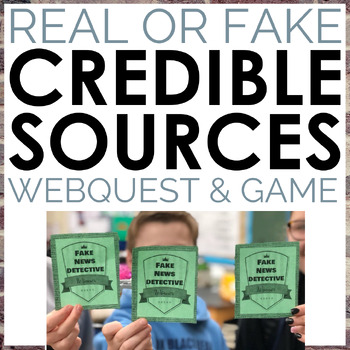Real News vs. Fake News: Evaluating Online Sources Webquest and Game
- Zip
- Internet Activities
- Webquests
What educators are saying
Description
Equip your students with the critical thinking and analysis skills they need to navigate the digital landscape with our "Real News vs. Fake News: Evaluating Online Sources Webquest and Game" now with UPDATED LINKS! Tailored for middle school and high school English Language Arts (ELA) teachers, this educational resource transforms the often challenging task of source evaluation into an engaging and interactive learning experience.
Key Features:
- Interactive Learning Journey: Take your students on a digital adventure where they learn to discern between credible and unreliable sources. Our webquest and game combination ensures active participation, turning a vital life skill into an exciting educational journey.
- Current and Relevant Content: Address the ever-evolving landscape of online information with up-to-date content. Explore real-world examples that resonate with today's youth, fostering a connection between classroom learning and the challenges they encounter online.
- Customizable for Various Classrooms: Our Webquest and Game are designed to seamlessly integrate into your ELA curriculum. Adapt the materials to suit your classroom's needs. This resource is completely editable.
- Critical Thinking and Media Literacy: Cultivate critical thinking skills and media literacy as students engage in hands-on activities. From evaluating news articles to deciphering social media posts, this resource empowers them to make informed decisions about the information they encounter.
Benefits:
- Arm students with the skills to navigate the digital information landscape responsibly.
- Foster a culture of critical thinking and media literacy within your classroom.
- Enhance ELA curriculum with a relevant and engaging resource.
- Prepare students for real-world challenges in an increasingly digital society.
Empower your ELA classroom with the tools needed to navigate the complexities of online information. Our "Real News vs. Fake News: Evaluating Online Sources Webquest and Game" is a comprehensive solution for middle and high school teachers seeking to instill critical media literacy skills in their students.
Includes two lessons:
- Day One: On day one, students will practice evaluating one criteria of the C.R.A.P. protocol at a time in a webquest. Students will be so engaged as they encounter interesting websites to evaluate!
- Day Two: On day two, students use the C.R.A.P. evaluation protocol in a stations game with a group. Students visit ten stations, working through the evaluation process and trying to identify all of the fake news. The students who identify the most fake news (and throw it in the Fake News Trash!) win Fake News Detective badges!
This two day lesson includes:
- Student worksheets
- Webquest
- Detailed lesson plans
- Links to real news and fake news sources
- Exit tickets for reflection
- PowerPoint to guide students and teachers through each lesson
Be sure to follow up this lesson with this Escape the Misinformation Newsroom digital escape room experience!





